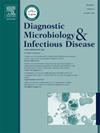Diagnostic performance of an in-house real-time polymerase chain reaction (PCR) assay and antigen detection from respiratory samples for the diagnosis of pulmonary cryptococcosis
IF 2.1
4区 医学
Q3 INFECTIOUS DISEASES
Diagnostic microbiology and infectious disease
Pub Date : 2025-05-22
DOI:10.1016/j.diagmicrobio.2025.116924
引用次数: 0
Abstract
Introduction
The currently available diagnostic tests lack sensitivity to diagnose pulmonary cryptococcosis. In the current study, we developed and standardized an in-house real-time PCR assay and evaluated the antigen detection in respiratory samples for the diagnosis of pulmonary cryptococcosis.
Materials and Methods
We standardized an in-house real-time PCR assay (using URA5 and STR1 primers; index test 1) and cryptococcal antigen detection (BIOSYNEX® CryptoPS, France) from the respiratory samples (index test 2). We considered a sample positive for PCR assay when both gene targets (URA5 and STR1) were detected. We prospectively enrolled subjects undergoing evaluation for non-resolving pneumonia and evaluated the performance of the index tests for diagnosing pulmonary cryptococcosis. The reference standard was proven or probable pulmonary cryptococcosis diagnosed by EORTC/MSG (European Organization for Research and Treatment of Cancer/ Mycoses Study Group) criteria.
Results
Of the 133 subjects enrolled in the study, two (2.66 %) and three (3.99 %) were diagnosed as having proven and probable pulmonary cryptococcosis. 3.8 % of study subjects had HIV. The sensitivity and specificity of qPCR (index test 1) for the diagnosis of pulmonary cryptococcosis were 60.0 % (95 % CI: 14.6-94.7) and 96.1 % (95 % CI: 91.1-98.7), respectively, while the sensitivity and specificity of antigen detection from respiratory samples (index test 2) were 40.0 % (95 % CI: 5.2-85.3) and 99.2 % (95 % CI: 95.7 -100.0), respectively.
Discussion
In-house PCR and antigen detection in respiratory specimens can potentially be used for early diagnosis of pulmonary cryptococcosis. Larger multicenter studies are required to confirm their utility.
内部实时聚合酶链反应(PCR)测定和呼吸样本抗原检测诊断肺隐球菌病的诊断性能
现有的诊断方法对肺隐球菌病的诊断缺乏敏感性。在目前的研究中,我们开发并标准化了一种内部实时PCR检测方法,并评估了呼吸道样本中抗原检测对肺隐球菌病的诊断作用。材料和方法我们标准化了内部实时PCR检测(使用URA5和STR1引物;指数测试1)和从呼吸样本(指数测试2)中进行隐球菌抗原检测(BIOSYNEX®CryptoPS,法国)。当检测到两个基因靶点(URA5和STR1)时,我们认为样品的PCR检测呈阳性。我们前瞻性地纳入了接受非溶解性肺炎评估的受试者,并评估了诊断肺隐球菌病的指标测试的性能。参考标准为EORTC/MSG(欧洲癌症研究和治疗组织/真菌病研究组)诊断的已证实或可能的肺隐球菌病。结果133例受试者中,2例(2.66%)和3例(3.99%)被诊断为确诊和可能的肺隐球菌病。3.8%的研究对象感染了艾滋病毒。qPCR(指标试验1)诊断肺隐球菌病的敏感性和特异性分别为60.0% (95% CI: 14.6 ~ 94.7)和96.1% (95% CI: 91.1 ~ 98.7),而呼吸道标本抗原检测(指标试验2)的敏感性和特异性分别为40.0% (95% CI: 5.2 ~ 85.3)和99.2% (95% CI: 95.7 ~ 100.0)。讨论呼吸道标本内部PCR和抗原检测可用于肺隐球菌病的早期诊断。需要更大规模的多中心研究来证实它们的效用。
本文章由计算机程序翻译,如有差异,请以英文原文为准。
求助全文
约1分钟内获得全文
求助全文
来源期刊
CiteScore
5.30
自引率
3.40%
发文量
149
审稿时长
56 days
期刊介绍:
Diagnostic Microbiology and Infectious Disease keeps you informed of the latest developments in clinical microbiology and the diagnosis and treatment of infectious diseases. Packed with rigorously peer-reviewed articles and studies in bacteriology, immunology, immunoserology, infectious diseases, mycology, parasitology, and virology, the journal examines new procedures, unusual cases, controversial issues, and important new literature. Diagnostic Microbiology and Infectious Disease distinguished independent editorial board, consisting of experts from many medical specialties, ensures you extensive and authoritative coverage.

 求助内容:
求助内容: 应助结果提醒方式:
应助结果提醒方式:


